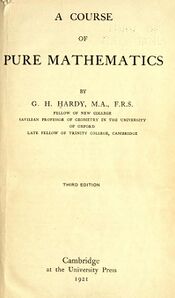A Course of Pure Mathematics
 Cover of Third edition, 1921 | |
| Author | G. H. Hardy |
|---|---|
| Country | England |
| Language | English |
| Subject | Mathematical Analysis |
| Publisher | Cambridge University Press |
Publication date | 1908 |
| ISBN | ISBN:0521720559 |
A Course of Pure Mathematics is a classic textbook in introductory mathematical analysis, written by G. H. Hardy. It is recommended for people studying calculus. First published in 1908, it went through ten editions (up to 1952) and several reprints. It is now out of copyright in UK and is downloadable from various internet web sites. It remains one of the most popular books on pure mathematics.
Contents
The book contains a large number of descriptive and study materials together with a number of difficult problems with regards to number theory analysis. The book is organized into the following chapters, with each chapter further divided.
I. REAL VARIABLES
II. FUNCTIONS OF REAL VARIABLES
III COMPLEX NUMBERS
IV LIMITS OF FUNCTIONS OF A POSITIVE INTEGRAL VARIABLE
V LIMITS OF FUNCTIONS OF A CONTINUOUS VARIABLE. CONTINUOUS AND DISCONTINUOUS FUNCTIONS
VI DERIVATIVES AND INTEGRALS
VII ADDITIONAL THEOREMS IN THE DIFFERENTIAL AND INTEGRAL CALCULUS
VIII THE CONVERGENCE OF INFINITE SERIES AND INFINITE INTEGRALS
IX THE LOGARITHMIC, EXPONENTIAL AND CIRCULAR FUNCTIONS OF A REAL VARIABLE
X THE GENERAL THEORY OF THE LOGARITHMIC, EXPONENTIAL AND CIRCULAR FUNCTIONS
Appendices
INDEX
Review
The book was intended to help reform mathematics teaching in the UK, and more specifically in the University of Cambridge and in schools preparing to study higher mathematics. It was aimed directly at "scholarship level" students – the top 10% to 20% by ability. Hardy himself did not originally find a passion for mathematics, only seeing it as a way to beat other students, which he did decisively, and gain scholarships.[1]
References
- ↑ "Hardy biography". 1947-12-01. http://www-history.mcs.st-andrews.ac.uk/Biographies/Hardy.html. Retrieved 2016-06-15.
External links
Online copies
- Third edition (1921) at Internet Archive
- Third edition (1921) at Project Gutenberg
- First edition (1908) at University of Michigan Historical Math Collection
Other
- A Course of Pure Mathematics at Cambridge University Press (10 e. 1952, reissued 2008)
 |

